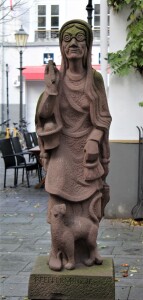Kickin in Koblenz
Back onboard the ship for cocktails and dinner. Collette’s really getting into this “having someone cook and serve” thing. It is nice, I must admit. We’ve had great meals on the ship. Breakfast has a buffet or you can order off an a la carte menu, or have an omelet made to order, lots of choices. And there’s always deserts for those who just can’t get enough sweets.
The next morning, we dock at Koblenz, famous for being the city where the Moselle and Rhine converge. First founded by the Romans in 9BC, it is one of Germany’s oldest and most beautiful cities. On the opposite side of the Rhine stands the “Ehrenbreitstein”, Europe’s second-largest preserved fortress. There is a cable car you can take to the fortress but we arrived too early and the car was not running. Besides, we have a guided city tour so on with the show.
We started at the confluence of the two rivers where a statue of Emperor William I, King of Prussia, was erected in 1891. The statue here today is not the original, that one was destroyed in WWII by Allied artillery. The new statue of William I was rededicated in 1953. Many battles and sieges have taken place here at the “German Corner”, and ownership of the city has changed hands many times. The French, the Swedes, the French again, the Russians, the Prussians, the Austrians and once again, the French have occupied this city since 1231. During WWII, Koblenz was home to the German Army Group B Command and was bombed heavily. Much of the city was destroyed.
One of the popular sites of Koblenz is St. Castor’s Basilica. Originally built between 817 and 836, there have been many re-constructions to the basilica. The basilica became a UNESCO World Heritage site in 2002. The fountain in front of the basilica is called, “Kastorbrunnen” (Castor well) and was built during Napoleon’s invasion of Russia in 1812.
 Some other unique sites around town, Schangel (Little Jean) spitting boy fountain. Erected in 1940 to honor poet Josef Cornelius who wrote the Schangellied (Schangel song) about the antics of little boys. The fountain “spits” water. This “spitting boy” is also found on the sewer covers throughout town.
Some other unique sites around town, Schangel (Little Jean) spitting boy fountain. Erected in 1940 to honor poet Josef Cornelius who wrote the Schangellied (Schangel song) about the antics of little boys. The fountain “spits” water. This “spitting boy” is also found on the sewer covers throughout town.
The History Fountain. The column, about 33 feet high, is covered with reliefs telling the history of the city in ten three-dimensional scenes. The history column is a gift from Landes Rheinland-Pfalz for the 2000th anniversary of the city of Koblenz, which was celebrated in 1992.
The Augenroller (Eye Roller) clock. Every half-hour this clock rolls its eyes and sticks out its tongue at the citizens of Koblenz. Rumor has it that the clock image was that of a statesman who was found guilty of a crime and beheaded but before doing so, he rolled his eye and stuck out his tongue at the executioner. Maybe, maybe not.
 The “Thumb” statue. One of four bronze versions of this “art” piece. Cast by artist Bocquel in the 1970’s and now resides outside the Ludwig Museum in Koblenz.
The “Thumb” statue. One of four bronze versions of this “art” piece. Cast by artist Bocquel in the 1970’s and now resides outside the Ludwig Museum in Koblenz.
Some more sites from Koblenz.

Peppermint Patty. Handed out peppermint sticks to the drunks so their wives wouldn’t smell the alcohol.
Back on the ship for a late lunch and sailing to our next destination, Heidelberg. This portion of the Rhine is called the “Rhine Valley” and is known for the many castles along the shore. Commonly referred to as, “ABC” or Another Bloody Castle.






 Statue of Lorelei, the siren of the Rhine Valley by Natascha Jusopov. Legend has it that she lures ships to their destruction at a point on the river where there is a 400’ rock outcropping. The water currents are very strong here and there are lots of rocks just below the surface. The name “Lorelei” comes from Old German meaning “murmuring rock.”
Statue of Lorelei, the siren of the Rhine Valley by Natascha Jusopov. Legend has it that she lures ships to their destruction at a point on the river where there is a 400’ rock outcropping. The water currents are very strong here and there are lots of rocks just below the surface. The name “Lorelei” comes from Old German meaning “murmuring rock.”


















